What is the Diamond Problem in C++
Introduction
“When two classes, B and C, inherit from class A as well as class D inherits from the two B and C, an ambiguity known as the "diamond problem" (which is also known as the “Deadly Diamond of Death”) occurs.”
A diamond problem represents a difficulty that arises when you use numerous inheritances in computer languages, particularly in C++. In C++, multiple inheritances are sometimes employed as a technique when the code is extremely long. Thus, we employ classes to control the program and to handle its source code. If the numerous inheritances are not handled appropriately, though, issues arise. The DIAMOND issue is the primary one in these situations. The primary causes of this diamond problem, the way it results from numerous inheritances, along with all the necessary remedies, are to be covered in this lesson.
System Requirements
You must require an Ubuntu system installed and configured on a virtual machine when you want to run the programs related to “C++ diamond inheritance” within the Linux operating system. There are two instruments utilized. One is any kind of editing tool therefore we’ll utilize Linux's built-in “text editor” for this. You can use your other favorite editing software. The Ubuntu terminal was another software. Whatever you will use to execute the application and view the output.
Since multiple inheritance within the source code poses the “diamond problem," we will first address multiple inheritances within this article.
Multiple Inheritance in C++ language
We always have knowledge about OOPs (Object-Oriented Programming) whenever we discuss the hierarchical usage of classes according to the program, due to the fact that a subclass's ability to inherit through one or multiple number superclasses is a crucial aspect of object-oriented programming. A child class comprises of two or more number of parents.
In a real-world scenario, for example, if a mother and father have their children, the child will receive every aspect from their parents. It is, therefore, recognized that the mother and father of the child belong to the derived class. Returning to the multiple inheritances. “Constructors” will be used throughout the course of this discussion. When there are multiple inheritances, the constructors within the inherited class (child class) run in the order that they were inherited. In contrast, the inheritance order is reversed for the destructors.
The multiple Inheritance function in C++ allows a class to inherit through multiple classes. The constructors of inherited classes are executed in the same sequence in which they were inherited. For example, the class second constructor is executed before A in the below program.
Example of Multiple Inheritance
# include <iostream>
using namespace std ;
class P
{
public:
P ( )
{
cout << " P's constructor is called here " << endl ;
}
} ;
class Q
{
public:
Q ( )
{
cout << " Q's constructor is called here " << endl ;
}
} ;
class R : public Q , public P
{
public:
R ( )
{
cout << " R's constructor called " << endl ;
}
} ;
int main()
{
R obj ;
return 0 ;
}
Output

Explanation
The next step is declaring class P, providing its constructors using the class name. Constructors, as you are aware, are called anytime an object gets created and are defined using the name of the class being used. A brief notice indicating which type of constructor is being used is shown in the constructor. Now, we apply the same methodology to define class B. The mention regarding the child class comes after both parent classes.
The sequence in which the child inherits from the parent classes is essential to notice since it affects how the constructor executes and what message it displays.
We will now construct an object from the child class inside the main class. It does not need the creation of an object for the parent class because it has multiple inheritances. The reason they execute automatically is due to the child class object.
Diamond Problem
A diamond problem describes a situation that arises only in cases of multiple inheritances, specifically when a child class inherits data from both of its parents. Whereas in an ordinary grandparent class is the source of inheritance for these parent classes. The inheritance hierarchy becomes ambiguous as a result, the unexpected behavior may result.
Example of Diamond problem
# include <iostream>
using namespace std;
class Person_class
{
public :
Person_class (int p)
{
cout << " Person class is called " << endl;
}
};
class Father_class : public Person_class
{
public :
Father_class (int p) : Person_class (p)
{
cout << " Father class is called " << endl;
}
};
class Mother_class : public Person_class
{
public :
Mother_class (int p) : Person_class (p)
{
cout << " Mother class is called " << endl;
}
};
class child_class : public Father_class, public Mother_class
{
public :
child_class (int p) : Mother_class (p), Father_class (p)
{
cout << " Child class is called " << endl;
}
};
int main ()
{
child_class child_obj (40);
}
Output

Explanation
The classes within the Mother class and Father class have been passed down to us as the Child class. A third class, called “person class," is inherited by these classes.
Thus, the program’s child class inherits the “person class” class twice, based on the situation that is provided. It comes from the mother class once and then from the father class the second time. The compiler becomes confused about which constructor should be executed first as a result. This leads to an inheritance graph with a diamond form. It is hence referred to as “The Diamond Problem”.
Solution for the Diamond problem
The solution is dependent on how the term “virtual” is used. In order to reduce the number of duplicates of a base class within the child class, two-parent classes that share a base class are now going to virtually inherits the base class. Irrespective of the number of derived classes inherited from the base class, you can make use of virtual inheritance to build a shared base class which only has one instance within the object hierarchy. In this manner, the common base class members may be accessed using the derived classes without any ambiguity, hence addressing the diamond problem.
- Virtual Inheritance: One way to make sure that each of the derived classes shares a single instance of the same base class is through the usage of virtual inheritance.
- Qualify the Function Calls: In the event where virtual inheritance cannot be available, you can qualify the function call to specifically indicate which method to apply.
When working with multiple inheritance with shared base classes in C++, these are the two typical approaches to solving the diamond problem. The exact needs and program design will determine which approach is best. We are going to use the keyword “virtual” and rewrite our code:
Program
# include <iostream>
using namespace std;
class Person_class
{
public :
Person_class (int p)
{
cout << " Person class is called " << endl;
}
};
class Father_class : virtual public Person_class
{
public :
Father_class (int p) : Person_class (p)
{
cout << " Father class is called " << endl;
}
};
class Mother_class : virtual public Person_class
{
public :
Mother_class (int p) : Person_class (p)
{
cout << " Mother class is called " << endl;
}
};
class child_class : public Father_class, public Mother_class
{
public :
child_class (int p) : Mother_class (p), Father_class (p), Person_class (p)
{
cout << " Child class is called " << endl;
}
};
int main ()
{
child_class child_obj (40);
}
Output

Explanation
The "Virtual” keyword is used when the parent class has inherited an attribute of the grandparent class; however, only in relation to the parents, a child cannot use it. This is called “the virtual inheritance”. It restricts the number of base class instances that can be provided in multiple number of times.
The constructor from a virtual base class cannot be accessed using the class which is inherited it in order to prevent the base constructor from having to be called again. Although the concrete class constructor calls this constructor. In the present example, the constructor associated with the “person” class is called directly by the child class.
Conclusion
In object-oriented programming, the idea of “diamond problem” is often used, especially in languages that enable multiple inheritance, such as C++. Whenever a class inherits through two or more classes which share a base class, a problem occurs. Although the derived class inherits numerous copies of the same base class, there may be conflicting or attribute references or ambiguous methods as a consequence of this common base class, which might cause complexity in the application. To avoid Diamond problem in C++ programming language the “virtual” keyword is used in the parent class.